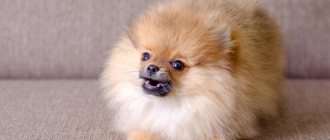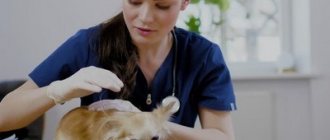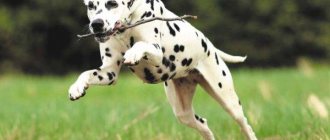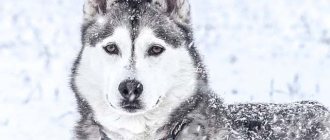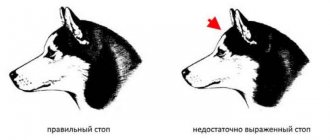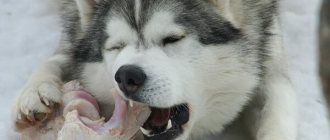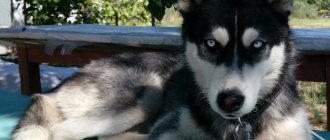Appearance and character
Behind the attractive appearance lies a friendly, cheerful, but firm character. Huskies are brave, resilient, hardworking, devoted to their owners, and kind to children.
Having decided to have such a dog as a pet, owners should know the peculiarities of raising, training and caring for this breed. If the owner shows the animal due attention and care, follows the rules of its maintenance, then the husky will definitely reciprocate and become a loyal and reliable friend.
Character and temperament
Initially, huskies were sled dogs and this determined their character traits. They are characterized by intelligence and independence - the leader himself chose the most convenient path, focusing on a given direction, everyone else worked in the same mode. Lazy dogs were punished by the pack itself, and this developed the breed's habit of working with full dedication, while appreciating the “contributions” of others. Hence the tendency of these dogs to imitate.
At the same time, they are weakly attached to the owner, since usually the team was used by different people.
We recommend this article:
How to Choose and Use a Clicker for Dog Training
The hunting instinct is highly developed and without socialization these dogs perceive other domestic animals as prey. Security instincts are very poorly developed.
There is a strong tendency to dominate: without proper training, huskies impose their own rules on their family, and even bite when they “disobey.” This breed is categorically not recommended for beginners, since it is very difficult for a beginner to train restive huskies correctly.
On the street, it is better to let them off the leash less often - huskies tend to run away and wander.
History of the breed
The name "husky" comes from a corruption of "Eski" - the designation of the northern Eskimo people. The Eskimos, as well as the Kereks, Chukchi and other northern peoples living in Eastern Siberia, have long used dogs of this breed for sledding purposes.
Animals in harness could run tens and hundreds of kilometers, transporting goods or people. Their food usually consisted of dried fish. Incredible endurance, the ability to get by on meager rations and devotion to their owners have been consolidated in the Husky breed for years.
With the start of the “gold rush” in North America and Alaska, the demand for a breed of this type sharply increased, and dogs began to be exported overseas. There they not only served economic purposes, but also, starting from 1908, participated in dog racing, were in demand and were actively bred.
At the beginning of the 20th century in the USSR, sled dogs were considered unpromising; they had to be replaced by air and motorcycle transport. Husky was excluded from the general register of dog breeds in Russia, and it was registered in the USA.
Husky puppy care
So, you have decided to make a faithful friend and reliable assistant - a husky dog.
It is better to purchase a puppy from a trusted breeder at the age of 5-8 weeks. Until this moment, the babies should be with their mother. At the age of 1.5-2 months, dogs begin to develop their character, they become receptive to education and training.
Before your pet finally settles in your home, you will need to purchase:
- dishes for food and water;
- collar;
- leash, halter;
- muzzle;
- dog toys that can be chewed and chewed;
- a weighted backpack to curb the activity of a young dog;
- cooling helium mat;
- furminator for combing wool.
Caring for a Husky is not difficult. The main thing is to provide the dog with maximum physical activity and proper nutrition.
A small husky will not be able to develop normally without sufficient physical activity. The owner will have to come to terms with the fact that once the puppy arrives, he will have to spend 3-4 hours a day on walks with him so that the pet can throw out his raging energy. And it doesn’t matter what the air temperature is - the baby will perfectly adapt to temperature conditions from -20 to +25 degrees.
Just jogging down the street while walking is not enough. The puppy needs at least half an hour a day to play outdoor games: in the summer with a ball, in the winter sledding in a harness (from the age of nine months), as well as endurance exercises.
Contents in the apartment
If your pet will live in a city apartment, you need to take into account that huskies are not a sofa decorative toy, they need space and movement. Since the breed is peaceful and friendly, a husky will not make a watchdog either.
You will have to walk the dog a lot and for a long time, otherwise you will have to prepare for damage to household items. The interior, wires, and shoes can especially suffer from the paws and teeth of inquisitive puppies. For this reason, it is necessary to start education and training from an early age. Dog toys will partly help solve the problem.
Sometimes a crate is used for puppies to isolate them while their owners are away from home. A sleeping mat is placed on the floor of the cage, creating a cozy home for the baby. When you return home, do not forget to immediately open the door so that the puppy can move freely in your presence.
To prevent an amusingly naughty baby from turning into an ill-mannered dog that irritates everyone, it is necessary from the first days of his life not to allow him to do things that would be prohibited to an adult dog: jump on people, sleep in the owner’s bed, climb on furniture, beg for food from the table.
How to feed a husky puppy for 3 months
You should not change the place of feeding. The puppy should have its own bowl with a capacity of approximately 2 liters, made of plastic or food-grade aluminum. It is chosen with a wide base to avoid frequent tipping. If your pet is on dry food, it is important to monitor the presence of water in the drinking bowl especially closely.
It is important to follow some mandatory rules:
- never force feed;
- do not give food from the table;
- strictly maintain the cleanliness of the bowl;
- eating only after a walk, not vice versa;
- maintain the same feeding times.
The volume of portions is selected taking into account individual needs. It is important to prevent excessive weight gain. Slight thinness without exhaustion corresponds to the breed standard. If you run along the spine and ribs, you can easily feel them. If this fails, you can reduce the number or volume of servings and analyze the nutritional composition. Excess weight can lead to problems with the cardiovascular system, digestion and skeletal formation.
Sometimes your pet may refuse to eat. This does not always indicate a disease: overeating is not typical for dogs of this breed. During the summer months, the amount of portions you eat may decrease. If your pet has not eaten anything for two days, this is not yet a reason to panic. If the fasting period continues longer, you should consult a veterinarian.
Hygiene
Your baby should be taught hygiene procedures as early as possible.
The shedding of a shaggy pet can cause a lot of trouble. Adult dogs shed twice a year. However, if the animal lives year-round in warm conditions, without a pronounced change of seasons, then the change in coat becomes less pronounced and not too noticeable.
The puppy is taught to be brushed as early as possible. This must be done at least twice a week, using a wide-tooth comb or a furminator that does not damage the living undercoat and guard hairs. After 5-6 months of age, the interval between combing can be increased to a week.
Caring for Siberian Husky puppies, in addition to regular brushing, includes:
- Bathing. Dogs of this breed are very clean, their fur does not have a specific smell, so water treatments once a year with animal shampoo will be enough.
- Cleaning ears and eyes once every two weeks. Eyes and ears are wiped with a cotton swab moistened with disinfectant liquid. This breed is prone to eye diseases, so ophthalmic drops are used prophylactically.
- Prevention of dental plaque. If tartar appears, it must be removed, preferably done in a veterinary clinic.
- Trimming nails and fur on paw pads. The claws are cut with nippers; in the cold season, the pads can be lubricated with wax to prevent cracks. Excess hair can cause discomfort to the dog, so it is best to remove it.
Development norms
A newborn husky puppy should weigh about 600 grams.
In the first days after birth, puppies do not see or hear anything, but they have an excellent reaction to touch and cold.
The main movements of a newborn are: moving the head, sucking and timid crawling. From birth, they should gain weight quickly and evenly.
So at two months of age their weight should be more than 5.5 kg.
The only proven method for determining the correct development of a puppy is periodic weighing: every day for the first fourteen days after birth.
Then weigh yourself only once a week. The development of newborn puppies is determined by the following indicators: good weight gain, excellent appetite, restful sleep after eating.
So, at the age of three months, the puppy’s weight should be more than 10 kg; by six months, the husky’s weight doubles (up to 20 kg). By the age of one year, husky puppies weigh more than 25 kg.
Nutrition
An important question that arises immediately when buying a puppy is what and how to feed the new family member?
Up to two months of life, the baby should receive six meals a day, from two months of age - five meals a day. At four months, the puppy is fed 4 times a day; after six months, three times is enough. This diet must be maintained for up to 10 months, then you can move on to two meals a day.
An adult dog (from one and a half years old) can be fed once or twice a day. It is imperative to follow a routine and give your pet food at the same time. From the age of four months they begin to add vitamin and mineral complexes to the diet:
- vitamins A and C increase immunity, help the body resist the effects of pathogenic bacteria and viruses;
- vitamin B keeps the coat, skin, and muscles healthy;
- vitamin D strengthens bones and joints, prevents rickets;
- vitamin E is involved in the formation of reproductive function;
- calcium, copper, iron, zinc, iodine are necessary for the formation of the skeleton, nervous system, blood cells and tissues, and the formation of proper metabolism.
Your veterinarian will tell you which vitamins to choose for your pet.
Owners can choose the type of food - ready-made food or prepare food for the dog from natural products.
Natural nutrition
If the owners decide to feed the puppy natural products, then they need to know a few rules:
- 50-60% of the diet consists of sea fish and lean meat - beef, rabbit, turkey meat. Huskies are sometimes allergic to chicken meat, so it should be introduced into the puppy’s menu carefully, in small portions. Offal products are useful - liver, heart, lungs, tripe. They contain a large amount of vitamins and microelements. Raw meat can be doused with boiling water or served raw. For small huskies, bones are more of a toy than a complete meal. They can be given to puppies up to 4-5 months of age, until the teeth are replaced.
- Husky puppies and adult dogs benefit from porridge made from buckwheat, rice, millet, oats with the addition of chicken or quail egg yolk once or twice a week. These products take up approximately 10-20% of the total food.
- 20% of the baby’s diet consists of fermented milk products - yogurt, cottage cheese, kefir, fermented baked milk.
- 10% should be allocated to vegetables - carrots, beets, cabbage, zucchini, pumpkin, tomatoes.
Dry food
Feeding your dog dry ready-made food and canned food is very convenient. But not all pet store products will be beneficial for your dog. You need to choose easily digestible premium and super-premium food. Cheap products contain a lot of starch, and the husky’s gastrointestinal tract does not tolerate it well.
Husky and old age
Aging is a natural process that, unfortunately, cannot be avoided. With proper care, you will maintain the health of your husky and temporarily delay the approach of old age.
Dogs that age may show mild symptoms of disease. It happens that it is difficult for the owner to understand the nature of the manifestation of the disease: chronic or associated with the development of dangerous diseases. It is important to carry out prevention on time. Dogs over 7-8 years of age must be examined regularly to monitor their health.
First of all, pay attention to changes in the body of an elderly dog. They can occur not only from the genetic characteristics of the husky and past diseases, but also from stress during training and use of the dog at work.
The claws of an aging pet need to be looked after, while jogging on the asphalt is enough for young individuals to sharpen their claws. As dogs get older, they become less active, which means their nails wear down worse. In addition, the gait of an older animal changes, which causes an uneven load on the paw. For this reason, unsharpened claws may form. They need to be trimmed when the claws reach the ground.
Changes in the aging body of a husky are also indicated by the condition of the skin: it becomes less elastic, less secretion is produced in the sebaceous glands, the coat becomes dull and dandruff appears. Some owners are bothered by the unpleasant odor that appears as their dog ages. It should be remembered that this is not the animal’s fault, but a natural process of changes in the skin. In this case, you need to wash the dog more carefully and dry it carefully. To do this, choose a special softening and moisturizing shampoo and conditioner. What to do if your pet is not accustomed to washing or it is difficult to do? Use dry lotions or shampoos. Huskies have the right to look good even in old age.
Older dogs lose visual acuity for a number of reasons: glaucoma, atrophy of the retina and optic nerve, age-related changes in the lens. If suddenly your pet’s eyes seem to be covered with a slight “haze”, and the dog refuses to walk when it’s dark outside, and overcomes small obstacles with caution, then be sure to consult a doctor. Fortunately, even with loss of vision, huskies easily adapt to orientation in space using hearing and smell. At the same time, the owner’s commands such as “forward”, “stand” and “calmly” will protect the dog from possible injuries, and will also give confidence to the pet.
As Huskies age, they lose their hearing acuity. This can cause inconvenience to the owner when, for example, during a walk the dog does not hear the owner’s commands. However, the husky will adapt to this. Living with a person, a dog is able to learn to recognize facial expressions and gestures without hearing verbal commands. She can feel the vibration of your hands clapping or if you stomp your foot. To understand how correctly your pet follows commands, just watch him.
Proper nutrition is extremely important for the well-being of an older animal. With the onset of old age, muscle mass decreases and fat deposits increase. The digestive system becomes more sensitive, so the diet of your elderly four-legged friend must be of high quality and easy to digest. To do this, you need to give special food for older dogs, which is rich in proteins and contains less fat. If necessary, switch your pet to a diet or medicinal diet. Food portions depend strictly on the recommendations of the veterinarian.
With age, oxidative processes occur in cells in a dog’s body. Because of this, the functioning of the immune system deteriorates and the aging process begins. It is important to diversify your pet’s diet and increase the number of vitamins and microelements in food, in particular antioxidants. In addition, a decrease in physical activity reduces the dynamics of intestinal function. Therefore, an older husky who is overweight needs food high in fiber. On the contrary, such a diet will be harmful for dogs that have difficulty gaining weight.
Protein-rich food has a beneficial effect on your pet's lifespan. The occurrence of signs of renal failure does not depend on the amount of protein. In the absence of clinical symptoms of this disease, it is not recommended to reduce the amount of meat or protein in dry food. Huskies over 6 years old should be given fewer foods high in phosphorus, such as fish.
Enuresis in a dog can be caused by excessive fluid intake. However, before limiting your pet's water, consult a doctor to find out the reasons for his thirst. They can also be diabetes mellitus, kidney failure, pyometra. If the animal is kept in an apartment, then in case of such violations, go outside with it more often to reduce the number of puddles on the floor in the house.
It is important to remember that walks should not be too long for an older husky, especially when the weather is cold or wet. If it’s warm and sunny outside, and the animal wants to rest and walk longer, then take your time and give him this opportunity. In older dogs, the body's thermoregulation deteriorates, so do not leave your pet in places where it is easy to become hypothermic or overheated.
A common problem for older dogs is osteoarthritis. Several signs may indicate a disease: the pet began to limp, the pace of walks decreased, and any physical activity became more difficult for him. As an example, an animal has difficulty getting up onto the sofa. It is recommended that a dog with osteoarthritis buy an orthopedic mattress that will help him lie down and get up, and provide additional warmth to the body during sleep. At the same time, swimming is extremely beneficial for aging joints. After bathing, dry your dog and its fur.
Old age can also cause cancer. An older animal is at risk, so once every two months, carefully examine and feel your four-legged friend. Take him to the vet about twice a year. If you notice any lumps on your dog's body, consult a doctor immediately.
Starting from 7-8 years of age, bring your dog to the veterinarian more often for a preventive examination. To monitor basic indicators, be sure to take a biochemical and general blood test, as well as urine. From the age of 8 years, echocardiography of the heart and ultrasound of internal organs are added. This must be done even if you do not notice any pathologies in your pet. The sooner the doctor identifies malfunctions in the dog’s body, the easier it will be to restore it to normal functioning according to its age.
Based on any symptoms, your veterinarian may recommend spaying or neutering your Husky. It is better to make such a decision in a timely manner and not delay the operation. After all, the older the animal, the more difficult it is for it to undergo surgery and recover from its consequences.
Older dogs are more likely to show tender feelings, so do not deny your pet attention and communication. Treat it with patience and give it more time and care.
Parting with a four-legged friend is always a painful process. You can soften it if you get a puppy in advance. However, an elderly animal will not always be happy with such a replenishment. With its activity and energy, a young individual will cause jealousy and irritation in an older pet, which can have a bad effect on its health. If your husky already feels weak and is unable to adequately fight with a young puppy for a place, lunch and a toy, then there is no need to rush to adopt a new animal. After all, the baby will have to devote more time and attention, and this can have a big impact on an old and sick dog.
Unfortunately, the owners of an old husky may have an unpleasant situation when the suffering and torment of the animal cannot be alleviated. The owner is faced with a difficult choice: to prolong the life of the pet no matter what, or to agree to euthanasia in order to stop the suffering of the old animal. There is no clear advice here, so everyone makes their own choice. Such situations are emotionally intense and unpleasant. It's hard to get over a loss, and it still takes some time to recover. However, it is always important to look to the future, so while your pet was with you, he was able to teach you a lot. And it is likely that someday you will want to share the knowledge you have gained with a new dog.
Training and education
From the first days of a little husky's life in a new home, it is necessary to give him a lot of attention and care. Walking together, feeding, exercising and caring for each other strengthens the mutual affection between owner and pet. During the first six months, owners must be especially patient, persistent and consistent. The reward for this will be a smart, obedient, infinitely loyal friend.
As soon as the baby adapts and gets used to the nickname, it’s time to set priorities and teach him discipline.
Husky puppies should not be allowed to play with household items and household items - socks, slippers, etc. It will no longer be possible to wean a grown dog from this bad habit. Some training tips for owners:
- The basic rule: the owner is the main one, the leader. He should be the first to start eating, enter the house, walk along a narrow path, etc.
- Violence is unacceptable. The owner must be firm, consistent and calm, use the words “no”, “stop”, “no”, ignore the dog’s wishes until the command is executed. In case of disobedience, the puppy must be taken by the withers, pressed to the floor or ground so that he cannot move and let go when he stops resisting and relaxes.
- There must always be an alternative: this is not possible, but this is possible.
- Reward for good behavior or completed command. Praise and recognition in the form of treats or approval in a gentle tone should follow immediately after the puppy's behavior or action.
- A list of specific rules that must not be violated. For each family they will be different: do not enter a certain room, sleep only in a certain place, sit at the feet of the owner if he stops during a walk, etc.
- A list of commands that must be strictly followed by the dog in any circumstances. These could be the words “stand”, “look”, “sit”, “place”, “to me”, etc.
Up to the age of six months, education is aimed at achieving the baby’s attachment to the family and his learning basic rules of behavior. For older puppies, training begins with a minimum number of commands and gradually progresses to complex exercises. A qualified dog trainer will help you train your dog professionally and effectively.
Diseases and vaccinations
Husky is an exceptionally hardy breed with strong natural health. And yet, in order to avoid possible problems, puppies need to be vaccinated from an early age.
The first comprehensive vaccination against common infectious diseases (distemper, enteritis, rabies) is carried out at the age of 8-9 weeks, and again after 3-4 weeks. Ten days before vaccination, the puppy is given deworming medication. After vaccination, home quarantine must be observed for another two weeks. Then the puppy can be taken for a walk. The dog will need the next revaccination at one year of age according to the same scheme.
It is important to protect your puppy from tick bites in the spring and summer. These parasites are carriers of the dangerous disease piroplasmosis, which can be fatal without treatment. As a preventive measure, you can use sprays, drops on the withers and anti-tick collars.
The weak points in the husky’s body that are most susceptible to diseases are the eyes, ears, skin, nervous system and joints. Sometimes puppies experience digestive upset, manifested in the form of diarrhea, lethargy, and lack of appetite. Body temperature may be increased. Most often, these symptoms occur due to dietary errors. In this case, you can give the baby sorbents against the background of a strict diet.
If the disorder does not go away on its own within two weeks, you should contact your veterinarian to prescribe medication. It will not be possible to protect your pet from all diseases, but proper nutrition and maintenance will help reduce the risks to a minimum.
After a year
In a year, the formation of the husky is still ongoing. A fully formed pet can be observed between two and three years. The weight of an adult dog ranges from 15 to 28 kg. It is clear that a bitch should be more graceful than a dog. The height at the withers is 50.5–62 cm, and the length along the back to the base of the tail is 50–60 cm.
Similar article: How to make your own booth and enclosure for a husky
Husky average weight table by week.
| age | weight | height |
| 4 weeks | 3 kg | – |
| 8 weeks | 5 kg | 30 cm |
| 12 weeks | 9.5 kg | 40 cm |
| 15 weeks | 13 kg | 45 cm |
| 20 weeks | 17 kg | 50 cm |
| 26 weeks | 20 kg | 55 cm |
| 30 weeks | 22,5 | 56 cm |
| 36 weeks | 24 kg | 57 cm |
| 40 weeks | 25 kg | 58 cm |
The owner needs to take into account that the weight and height of a husky are average, so only significant deviations from the norm should be of concern.
Ultimately, the size of the dog will depend on feeding, health, and genetics. Note that proper nutrition and care in the first year of a puppy’s life determines how healthy the four-legged friend will be in the future.
